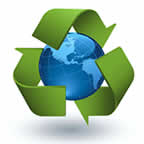
PET is a remarkably energy-efficient packaging material. Add to that its strength, versatility, and recyclability, and PET boasts an excellent sustainability profile.
Although the feedstocks for PET are petroleum based, the environmental impact of PET is very favorable in comparison to glass, aluminum and other container materials. PET’s exceptional capacity-to-weight ratio is a key to its energy efficiency, putting more product in less packaging, utilizing less weight and less fuel for transporting.
Ongoing advances in technology continue to decrease the weight of PET containers and to boost the energy efficiency of PET even more. For example, a two-liter PET bottle weighed approximately 68 grams in 1980; today it weighs between 42 and 45 grams.
Recycling Adds to PET’s Sustainability
The outstanding recyclability of PET further enhances it sustainability, providing an effective and efficient means of recapturing and reusing the energy and resources of its raw materials.
Although many Americans assume PET can only be recovered and recycled into non-food items such as carpet, clothing and engineering applications, technological advances over the past decade have made it possible to create recycled PET that meets the same hygienic and safety standards as virgin PET.
The closed-loop recycling of used PET bottles into new food-grade PET containers is one of the most desirable means of dramatically extending the environmental benefits and sustainability of PET as a packaging material.
Positive Life Cycle Studies
Life cycle studies of PET’s energy use and greenhouse gas emissions have consistently shown that PET offers an outstanding eco-profile among packaging materials.

A 2007 U.S. study found that PET bottles generated lower levels of greenhouse gas emissions, required less energy and resulted in less post-consumer solid waste than a bioplastic known as polyactide or PLA. 1
Two different life-cycle studies conducted in 2009 found that carbonated soft drinks bottled in PET used less energy, created fewer greenhouse gas emissions and generated less solid waste than sodas in glass bottles or aluminum cans.2, 3
The recycling of PET improves its positive eco-profile even further. A 2010 life-cycle study on recycled PET found that producing one ton of clean recycled PET in place of virgin PET saved an additional 48 million BTUs of energy and reduced greenhouse gas emissions by another 3,000 pounds.4 Recycling PET makes a good thing even better.
It’s important to remember that even the best of life cycle studies are imprecise and subject to disagreement. They’re unable to take into consideration every aspect of a material’s environmental and economic impact, and by their nature, rely significantly on assumptions, averages and mathematical extrapolations.
Nevertheless, the consistently strong performance of PET in numerous life-cycle studies confirms the positive eco-profile and sustainability of PET.
1 Franklin Associates, LCI Summary for PLA and PET 12-ounce Water Bottles; 2007
3Franklin Associates, Life Cycle Inventory of Three Single-Serving Soft-Drink Containers; 2009
